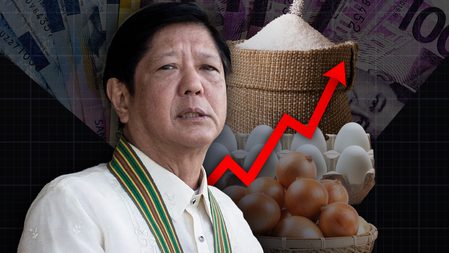SUMMARY
This is AI generated summarization, which may have errors. For context, always refer to the full article.

MANILA, Philippines – Although President Ferdinand Marcos Jr. boldly proclaimed “the State of the Nation is sound,” the rosy picture of the economy that he painted during his second State of the Nation Address needs more context to capture the reality of the Philippines.

The bulk of Marcos’ more than hour-long speech focused on the economy and business, and throughout, the President cited several figures to showcase the country’s supposedly impressive economic recovery. (READ: FULL TEXT: President Marcos’ State of the Nation Address 2023)
“Our economy posted a 7.6% growth in 2022 – our highest growth rate in 46 years,” Marcos said, which was the first figure that he cited in the SONA.
“We are still considered to be among the fastest-growing economies in the Asian region and the world. It is a testament to our strong macroeconomic fundamentals.”
While this is technically true, the growth rate needs to be placed in context. Much of the growth came after recovering from a pandemic that crashed the economy and even caused it to contract by 9.5% in 2020. Although the Philippines gross domestic product (GDP) growth did pick up in 2021 and 2022, it was still not enough to bring the economy back to its pre-pandemic trajectory. To return to this level by 2028, annual growth would have to reach 9.4% per year. (WATCH: EXPLAINER: Ano ang GDP?)
When it came to inflation and rising prices – the top issue for Filipinos online ahead of the SONA – Marcos said that prices of goods have already started to drop. He also noted that inflation was “moving in the right direction” after it clocked in at 5.4% in June.
“Sa mga nakalipas na buwan, nakita natin ang pagbaba ng presyo ng bilihin sa iba’t ibang mga sektor,” Marcos said. “Napatunayan natin na kayang maipababa ang presyo ng bigas, karne, isda, gulay, at asukal.”
(In the past few months, we’ve seen prices of goods go down across various sectors. We’ve proven that we can lower the price of rice, meat, fish, vegetables, and sugar.)
However, Marcos’ claim that the prices of goods were decreasing is misleading. Consumer price index data, which is computed based on average prices relative to 2018, showed that the prices of rice, meat, fish, vegetables, and sugar in the past few months has either increased or stayed the same.
In his first year as president and concurrent agriculture chief, Marcos also saw skyrocketing prices of kitchen staples onion (up 560% at peak from June 2022), sugar (40% jump from June to August 2022), and eggs (40% rise since June 2022) – all of which have yet to fully recover.
Although inflation has “eased” lately as Marcos correctly claimed, it’s important to remember that this does not imply prices are decreasing. Inflation is often measured as the rise of the prices of goods and services over a period of time, and a positive rate means that prices have risen during that period. So when inflation rate is lower in one period compared to another, it only means that prices are increasing at a slower rate. Even with decelerating inflation, prices today are still significantly higher than they were last year.
Simply put, a slowing inflation rate is not a drop in prices.
Marcos also mentioned that the employment rate rose to 95.7%, which he called “clear proof” that there was an improvement from the “severe unemployment” during the pandemic. But a notable point here was what Marcos chose not to address during the speech: the rise of unpaid workers.
Of the newly employed workers in the country, over a million are considered “unpaid workers.” An unpaid family worker is defined by the Philippine Statistics Authority as someone who works without pay on one’s own family-operated farm or business by another member living in the same household. Food or allowances do not count as salary.
– Rappler.com
Add a comment
How does this make you feel?

![[In This Economy] Marcos’ POGO ban is popular, but will it work?](https://www.rappler.com/tachyon/2024/07/thought-leaders-marcos-pogo-ban.jpg?resize=257%2C257&crop=255px%2C0px%2C720px%2C720px)
![[Rappler Investigates] POGOs no-go as Typhoon Carina exits](https://www.rappler.com/tachyon/2024/07/newsletter-graphics-carina-pogo.jpg?resize=257%2C257&crop=424px%2C0px%2C1080px%2C1080px)



![[EDITORIAL] Apat na taon na lang Ginoong Marcos, ‘di na puwede ang papetiks-petiks](https://www.rappler.com/tachyon/2024/07/animated-bongbong-marcos-2024-sona-day-carousel.jpg?resize=257%2C257&crop=280px%2C0px%2C720px%2C720px)
![[In This Economy] Delulunomics: Kailan magiging upper-middle income country ang Pilipinas?](https://www.rappler.com/tachyon/2024/07/in-this-economy-upper-middle-income-country.jpg?resize=257%2C257&crop=421px%2C0px%2C1080px%2C1080px)

![[EDITORIAL] Marcos Year 2: Hilong-talilong](https://www.rappler.com/tachyon/2024/07/animated-bongbong-marcos-2nd-sona-carousel.jpg?resize=257%2C257&crop=136px%2C0px%2C720px%2C720px)
![[Newspoint] A fighting presence](https://www.rappler.com/tachyon/2024/07/thought-leaders-a-fighting-presence.jpg?resize=257%2C257&crop=441px%2C0px%2C1080px%2C1080px)
There are no comments yet. Add your comment to start the conversation.